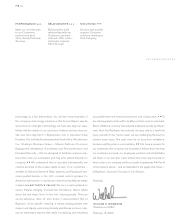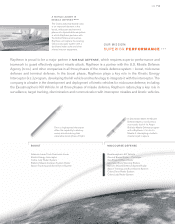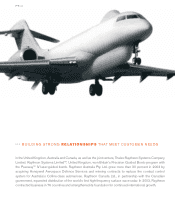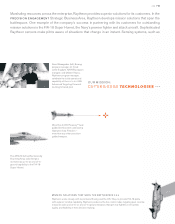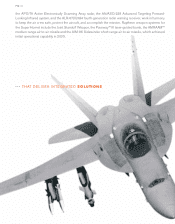Raytheon 2003 Annual Report Download - page 15
Download and view the complete annual report
Please find page 15 of the 2003 Raytheon annual report below. You can navigate through the pages in the report by either clicking on the pages listed below, or by using the keyword search tool below to find specific information within the annual report.
P13 333
SPACE AND AIRBORNE SYSTEMS (SAS), which reported sales of
$3.7 billion in 2003, is delivering impressive results on numerous programs
and directing Raytheon’s domestic and international business pursuits in several
areas. 33Space and Airborne Systems is well positioned to take advantage of the
resurgent federal interest in space exploration. Sensors built by the business for the
National Aeronautics and Space Administration began exploring Mars upon arrival
in January 2004. Raytheon will supply up to seven visible infrared imaging radiometer
suite (VIIRS) instruments for the National Polar-orbiting Operational Environmental
Satellite System. The first VIIRS instrument is scheduled for launch in 2006.
33After a superlative Navy evaluation of the Advanced Targeting Forward-Looking
Infrared (ATFLIR), developed for the F/A-18, pilots are anxious for widespread use.
The Navy has asked for full-rate production. The ATFLIR can observe a target, des-
ignate it for attack, or choose a target designated by another observer. 33The Navy
conducted the first flight test of another SAS system for the F/A-18, the revolutionary
APG-79 Active Electronically Scanning Array radar. The flight verified the success-
ful integration of the radar with on-board avionic systems and showed that various
subsystems were working properly. 33The Air Force awarded the business a con-
tract to continue upgrading the radar on the B-2 bomber. This is the second phase
of a multi-year program to retrofit the B-2 fleet with a new Ku-band active-array radar
antenna. Raytheon is a partner in the Multi-platform Radar Technology Insertion
Program for the E-10A, an airborne command post in development by the Air Force,
and SAS is spearheading Raytheon’s bid for the aircraft’s battle management com-
mand-and-control system contract. 33Led by Space and Airborne Systems,
Raytheon is serving as prime contractor and system integrator on the Airborne
Stand-off Radar (ASTOR) program for the United Kingdom. The company is win-
ning international recognition for designing and developing ASTOR on schedule
and within budget. This effort earned Raytheon an invitation from the North Atlantic
Treaty Organization (NATO) to bid on developing an airborne surveillance system
that NATO expects to field by 2010. 33Global Hawk and Predator®unmanned aer-
ial vehicles owed much of their success in Operation Iraqi Freedom to Raytheon
sensing and targeting systems. Unmanned systems represent a high-growth oppor-
tunity that Raytheon is pursuing aggressively. 33With significant success, the
business continues to receive and perform on new classified program awards.
33SAS continues to be at the forefront of advanced systems for intelligence, surveil-
lance and reconnaissance; precision engagement; and missile defense.
JACK KELBLE
President
3
Equipped with sensors and other electronic systems
developed by Raytheon, the Global Hawk®unmanned
aerial vehicle performed superbly in Operation Iraqi
Freedom. Although it flew less than 10 percent of the
intelligence and reconnaissance missions, it accounted
for more than half of the targets generated to destroy
air defenses. The wireframe in this image reveals the
location of the Integrated Sensor Suite that Raytheon
produces for the Global Hawk.
SPACE AND
AIRBORNE SYSTEMS
333


